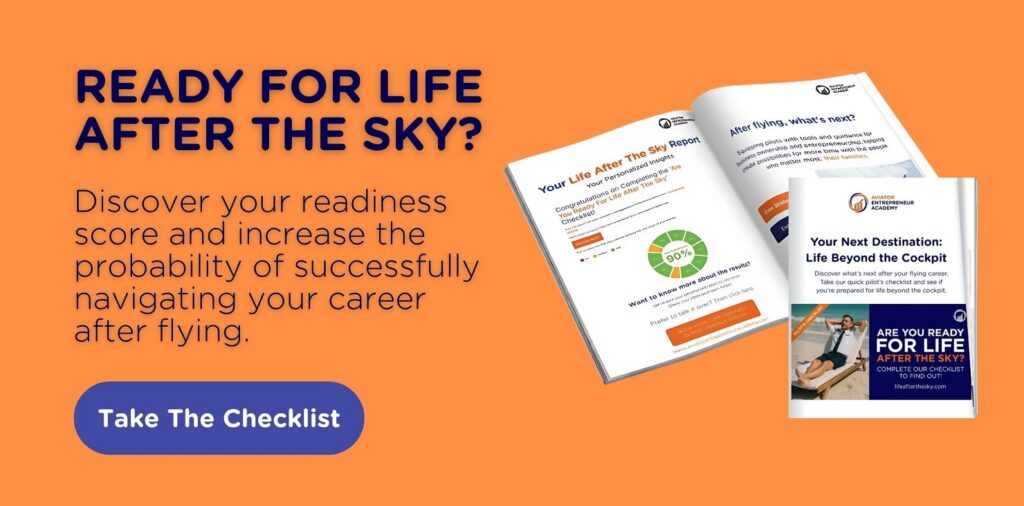You’ve hung your wings, the logbook is closed and the uniform stored away. But three months into “life after the sky,” reality hits a little harder than expected.
The returns from your rental property barely cover the mortgage, the market’s down, and the investment you were counting on are dragging. Don’t forget the side hustle that still feels more like a hobby than an income stream.
When pilots are asked about their plan after flying, most of them say that they’ll either invest in stocks or property or start a side hustle. It’s not our fault, as we’ve been told for years, that passive income is the dream.
The problem isn’t the idea of passive income, it’s the way we approach it: too casually, too late, and with zero structure.
Below, we’ll discuss the four common income illusions that trap pilots and explain how they can gain more freedom and a far better altitude.
Key Takeaways
- Real estate and stocks aren’t passive: They sound passive, but often require time, energy, and discipline. Real estate needs maintenance, and stock markets demand timing.
- Your pension won’t be enough: Pensions are shrinking and fixed. With rising costs and longer lifespans, relying on them alone can leave you short.
- Consulting still trades time for money: Consulting uses your skills, but it’s still a job. You’re tied to clients, hours, and income uncertainty.
- Side hustle stays small without a plan: Starting something on the side sounds promising, but without structure, most side hustles stay small.
- Build with intention: Look beyond myths. Build a system that runs without you. Use your discipline to create digital products, automated services, or scalable coaching models.

The 4 Passive Income Myths Stopping Pilots from Taking Off
After speaking with many pilots over the years, most had the same fallback plans: either invest in an asset or start a side hustle (after retirement). Those ideas sound responsible, safe, and familiar, but they have one fatal flaw: they weren’t built to scale or survive real turbulence.
Let’s break those myths so you don’t repeat the same mistakes many pilots make.
Myth 1: “I’ll Invest in Real Estate or the Stock Market”
On paper, this myth seems like a no-brainer. Pilots are usually high-income earners with disciplined savings habits, so the idea of putting that money into “working assets” like property or stocks feels smart and safe.
But real estate and stock investing aren’t truly passive and rarely offer the freedom most pilots seek.
Let’s start with real estate. Sure, the idea of rental income while you fly sounds great, until you’re managing repairs, tenant issues, or navigating volatile housing markets. In fact, according to Bankrate, the annual average ROI for residential real estate was around 10.6%, and the yearly average for commercial real estate was even lower.
Then there’s the stock market. While index funds and dividend portfolios offer potential returns, the average retail investor earns 3% to 4% less annually than the market average. It’s primarily due to emotional decisions and poor timing.
Myth 2: “My Pension Will Take Care of Me”
For many pilots, the pension or End of service Benefits(EOSB) represents a hard-earned safety net, a comforting promise after decades in the cockpit. It feels like a steady tailwind you can rely on once you’re done flying. But the harsh truth is that pensions are now shrinking and often don’t match the lifestyle you’re looking for after retirement.
Many airline pension plans were designed decades ago, when pilots retired earlier and healthcare, inflation, and life expectancy were very different. Today, pilots are living longer, often 20 or more years post-retirement, and expenses keep rising.
Even though the current inflation rate is only 2.3%, it was once 8.5% just three years ago. If that happens again, it could significantly erode the value of the fixed pension.
In aviation terms, pensions can be defined as the landing gear and not a propulsion system. They can help soften your descent, but they won’t power your next climb.
The problem isn’t us, but the outdated financial playbook that we were handed. However, the good news is there’s always a better way forward. And it starts with rethinking the tools available to us for making it big after we’ve hung our wings.
Myth 3: “I’ll Just Do Freelance Consulting”
Consulting sounds like a perfect post-flying gig: use our expertise, work our own hours, and keep a foot in aviation. For many pilots, it feels like a fitting next step.
But the reality? Freelance consulting often means trading one schedule for another. It’s still time-for-money, and time is our most limited resource especially once we leave the cockpit.
Consultants face feast-or-famine cycles, sometimes overloaded with work, sometimes struggling to find clients. Unlike flying, where we have a clear contract or schedule, consulting income can be unpredictable and unstable, especially early on.
The point is, without building systems or scalable offerings, consulting remains just another paycheck earned by the hour. And we believe that’s not what we’re looking for after years of flying.
Myth 4: “I’ll Start a Side Hustle on the Side”
Side hustles have become the go-to fallback for many pilots. The idea of building a small business or earning extra income on the side while still flying sounds practical, and for some, it actually is.
The challenge is that without focus, structure, and a clear plan, most side hustles remain just side projects—hobbies that demand energy but don’t produce outcomes.
According to Omnisend, almost half of all adults have a side hustle, but almost 50% of them make less than $500 per month. After earning hundreds of thousands of dollars annually, $500 might not be enough for pilots to live the life they dreamed of.
Side hustles can be a great start, but only if we commit to turning them into real ventures. Otherwise, they’re just more time spent spinning propellers on the tarmac.
What Actually Works: Structured, Scalable Income
If our thoughts align with the myths we’ve discussed, it’s time to try a different approach. One that is built with precision, discipline, and foresight, which pilots already know well.
It’s called Aviator Entrepreneurship.
It means building a business designed to scale, automate, and deliver sustainable returns without trading every hour of our day for dollars.
The key?
Focus on scalable business models. These are ventures that don’t require you to be the bottleneck. Think digital products, automated services, membership platforms or niche coaching.
Automation and systems let your business work while you’re flying, spending time with family, or recharging after a long day.
Pause, Reflect, and Prepare for What Comes After Flying
Hoping passive income will magically lift us off the ground after leaving the cockpit won’t cut it. We need thoughtful planning, discipline, and building income streams that genuinely work for us and not against our time and freedom.
It might be time for a moment of reflection. How clear is our plan? How confident do we feel about our financial approach?
Taking a few minutes to assess our readiness can make all the difference.
If you’re curious to see where you stand, take our quick 3-minute quiz designed just for pilots facing this shift.
Invitation to join our FREE Strategy Session
Most pilots are one honest conversation away from clarity. This is that conversation.
Complete our “Life After the Sky” checklist, then join me for a FREE 15-minute “Strategy Session” via Zoom.
This session has been created for pilots who want to take ownership of what comes next.
Those who want action, not just to talk about it.
In just 15 minutes, we’ll:
- Review your checklist results
- Identify the one obstacle holding back your reinvention
Translate your checklist results into a clear starting point
Start your pre-flight assessment for the next chapter of your journey by Booking your free strategy session here!



